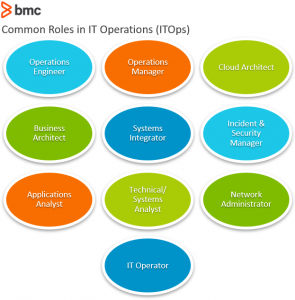IT Operations (ITOps) refers to the processes, practices, and even IT services necessary to meet the business needs of internal and external users. In simple terms, ITOps professionals ensure IT service delivery by supporting appropriate processes to run a successful IT-enabled business.
In this article, we will discuss the roles and responsibilities of ITOps and highlight the new technology advancements that have transformed the IT services landscape.
Functions in IT operations
Today, IT can be run in a variety of ways. In the last decade, IT organizations that have embraced DevOps and Agile ways of working have actually redefined and reshaped the way services are delivered. That means that the roles, job titles, and corresponding responsibilities of any IT operations group can vary widely.
So, let’s start by looking at the IT functions covered by various roles in IT Operations Teams:
Network infrastructure
Under the umbrella of networking infrastructure are these functions and practices:
- Configurations and network management
- Firewall management
- Providing mechanisms for identity and access management according to organizational policies
- Monitoring network infrastructure health and traffic flows
- Hardware deployment, upgrades, and support
(Read more about enterprise networking.)
Server management
Server management encompasses these activities:
- Managing and provisioning infrastructure resources for internal users such as DevOps teams and external users including customers and partners
- Managing configuration changes and IT workloads
- IT infrastructure management functions including configuring, managing, and delivering IT environments using on-site and off-side data center and cloud infrastructure resources
- Managing software licensing and upgrades
- Setting up and authorizing software, hardware, and server resources for new users
Service desk support
In any IT organization, the service desk support might be included within a specific IT service management (ITSM) department or IT Operations more generally. Common activities include:
- Troubleshooting issues
- Managing help desk and ticketing systems
- Coordinating with the service desk to identify and mitigate root cause issues pertaining to the IT infrastructure and systems
- Developing a disaster recovery and risk mitigation plan
- Working with external partners, auditors and consultants on risk management and regulatory compliance projects
(Compare the help desk to the service desk.)
Incident & security management
Traditionally a standalone department, security and incident management are becoming more and more crucial to all areas of IT, especially in explicitly SecOps or DevSecOps organizations. Activities in this area include:
- Implementing proactive, preventive, and reactive maintenance measures
- Implementing and using technology systems to detect patterns of anomalous network and security behavior
- Managing identity and access controls, organizational security policies, and industry-proven security best practices across the on-site and cloud-based infrastructure systems
- Architecting IT environments with sufficient redundancy, duplication, and security protection against natural, internal, and external threats that may compromise information security and service availability
- Developing and implementing service level agreement (SLA) standards necessary for successful IT-enabled business operations

ITOps + DevOps functions
Of course, IT operations does have some intersecting responsibilities that also support application and software, including development and testing. In particular, DevOps does bring IT operations personnel closer to IT applications teams in the following areas:
- Application support, configurations, installations, and troubleshooting
- Database maintenance
- Application and infrastructure monitoring
- Network management
- Service desk support
- Financial auditing and reporting
- IT Operations help desk and support
These responsibilities are assigned across several roles, as your IT organization deems most appropriate and effective.
Common IT Operations job titles
Let’s review some of the most common ITOps roles in an enterprise IT organization:
- Operations Engineer manages operations for environment implementation, application deployment and optimization of ITSM framework best practices.
- Operations Manager oversees the design and implementation of ITOps from a business and technical aspect.
- Cloud Architect designs the cloud environment with respect to the organization’s business requirements. Additional responsibilities include Infrastructure deployment, maintenance, monitoring, management, and security.
- Business Architect interprets organizational policies, risks and goals, and bridges the gap between strategy and execution. Synthesizes the strategy development process across all departments to ensure that the collective vision of all teams are aligned with the organization.
- Systems Integrator designs, builds, and synthesizes all IT system subsets used collectively to deliver an IT service or solution.
- Incident and Security Manager develops strategies and systems that help reduce risk and maximize dependability of an IT service.
- Applications Analyst is responsible for monitoring, administration, and maintenance of software applications, interacting data and the underlying IT infrastructure.
- Technical/Systems Analyst analyzes how IT systems, solutions and applications fit with the business needs of the organization. Defines and analyzes system performance, standards, and issues.
- Network Administrator configures systems, identifying, and solving network issues; budgeting, maintenance, and management of network resources.
- IT Operator deploys, installs, and sets up devices for users. Responding to service requests by fixing issues, replacing, or upgrading equipment.
(Read about IT/business alignment.)
AIOps for IT operations
One of the primary challenges facing IT Operations teams is the sheer scale of tasks involved in effectively managing and delivering services to a large user base. Advancements in artificial intelligence and machine learning have presented ITOps as a popular use case in enterprise settings, especially environments where IT infrastructure is growing in complexity and generates vast volumes of data.
The use case has taken the title of AIOps—Artificial Intelligence for IT Operations. According to AIOps of “big data and machine learning to automate IT operations processes, including event correlation, anomaly detection and causality determination.”
Some of the popular AIOps vendors include:
- BMC
- AppDynamics
- NewRelic
- PagerDuty
- Splunk
(Explore AIOps solutions from BMC.)







